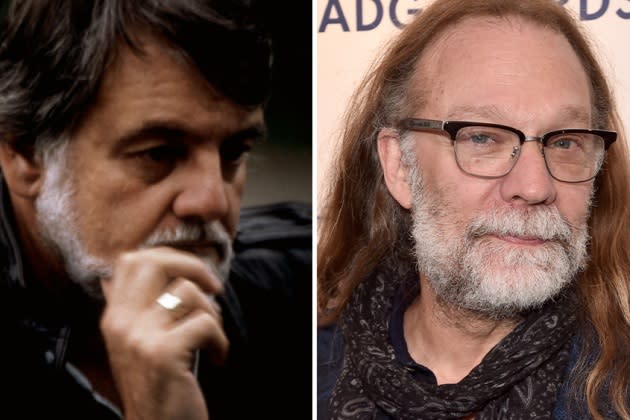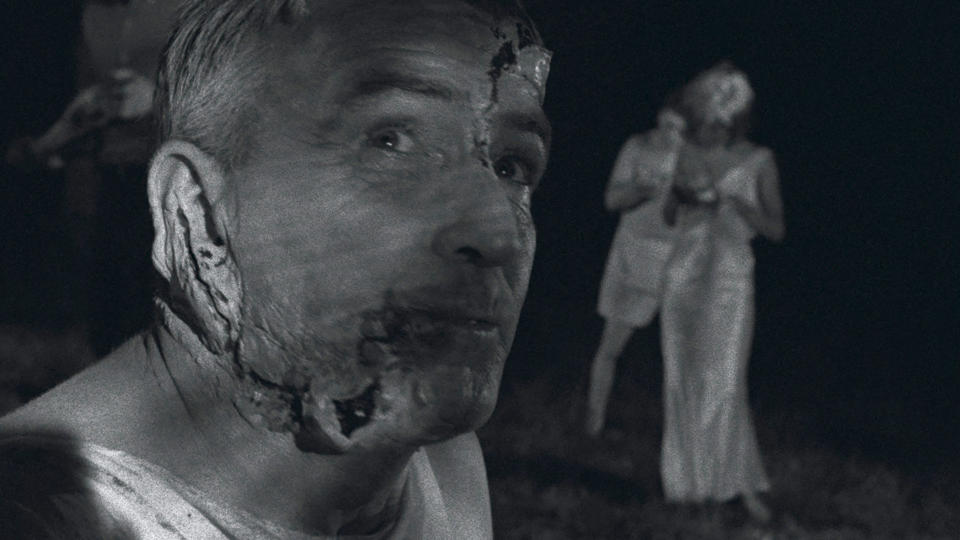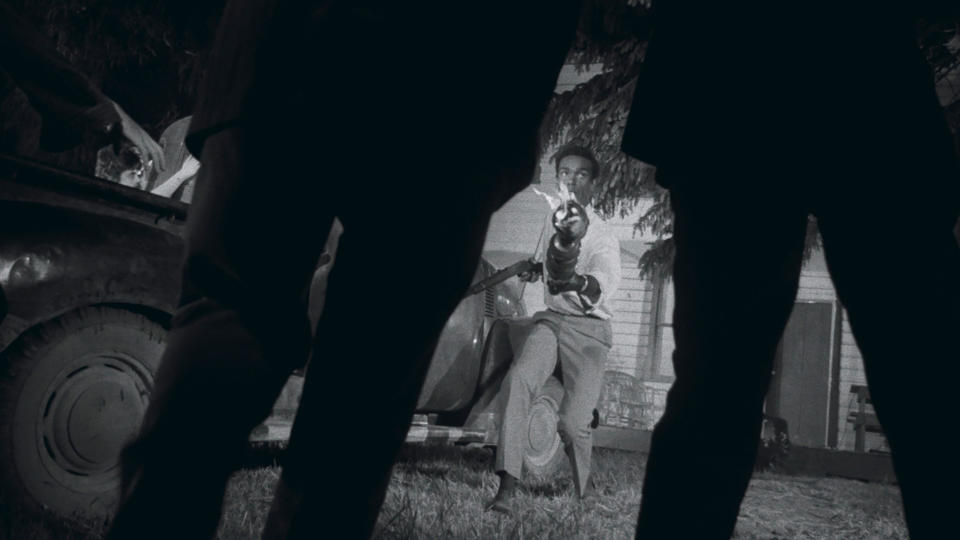‘The Walking Dead’s Greg Nicotero & Jimmy Miller To Make Film On The Making-Of George Romero’s Zombie Classic ‘Night Of The Living Dead’
- Oops!Something went wrong.Please try again later.
- Oops!Something went wrong.Please try again later.
- Oops!Something went wrong.Please try again later.
- Oops!Something went wrong.Please try again later.

EXCLUSIVE: As reams of Comic-Con attendees mill around dressed as flesh eaters or take part in zombie-themed events, filmmaker Greg Nicotero and his Monster Agency Productions has teamed with Jimmy Miller’s Mosaic to mount a movie about the making of George Romero’s 1968 film Night of the Living Dead. From unlikely origins and a budget around $115,000, the film hatched the whole zombie genre and is regarded as arguably the greatest horror movie ever.
Everett
More from Deadline
Nicotero is one of many creatives in film, TV and video games who’ve benefited from Romero’s pioneering in the carnivorous-corpse genre. He has directed 39 episodes of The Walking Dead, including the series finale he’s still finishing. Although he’s got a long list of genre credits, Nicotero actually learned his craft on Romero’s films. They are both from Pittsburgh — and so, for that matter, is Miller — and they all knew each other well. Nicotero said the idea for the movie came after he attended a memorial for the Romero, who died in 2017. There, he heard the filmmaker’s old friends swap stories about the making of his groundbreaking film. The chance that these Pittsburgh creatives who made commercials and industrial films together could turn out such a revered horror film on their first try still boggles Nicotero’s mind.
“They really had no experience,” he said. “One of the actors was the makeup artist. It was this bunch who’d shot a couple commercials, sitting around saying, ‘Hey, we should make a movie.’ And someone in the group said, ‘Yes, let’s make a horror movie. They always make money.’ I love that spirit of a group of people getting together who had no real idea what they were doing and fumbling their way through.
“They found this rickety old farmhouse in Pennsylvania,” he said. “One of the interesting things to me is, when you watch the movie, it has this sense of film noir because of the way the lighting is. A lot of that is, they just didn’t have money to afford a lot of lights. So they created a very unique lighting style for a lot of scenes, which played into the motif of what Night of the Living Dead is about. Even when they struck the prints to distribute, they used cheap film stock, so there was a lot of contrast. Everything that was black went black and everything white went really white. That added to this weird noir film vibe of, what’s going to come out of the darkness and get me? It was a perfect storm of events with a group that loved working together and rolled up their sleeves.”
Nicotero said the graveyard is a pilgrimage destination; it’s where Romero shot the opening scene when a zombie interrupts two siblings as they lay a wreath on their parents’ headstone. Nicotero said he has taken Simon Pegg and Quentin Tarantino there to stand in the famous spot. The farmhouse has long been torn down. “It’s not like Poltergeist, where they moved the headstones; the graveyard is exactly as they left it,” he said.
After the Romero memorial, where his friends recalled the antics on the set and Romero’s eccentric tics – “he would wear a cape to go out with friends, dressed as Zapata from Viva Zapata, and he had no game with the girls” – Nicotero had the idea for the film he will direct. They’ve tied up the necessary rights and are working with Romero’s widow, Suzanne DesRocher-Romero, with Nicotero and Miller producing along with Brian Witten for Monster Agency and M. Riley for Mosaic. They’re going out to writers immediately.
“What I want to do is an Ed Wood-style movie that shows the heart and character of this guy, with the backdrop this Magnificent Seven version of a bunch who had no f*cking idea of what they were doing, getting together to make Night of the Living Dead.”
He’ll shoot the re-created scenes from the original film in black and white but the rest in color, explaining that you have to be able to see things like how they melted chocolate to serve as the blood.
Everett
Aside from being an unsung horror film pioneer, Romero’s experience on his most famous film was painful in the end. Night of the Living Dead grossed $30 million and has netted around $200 million, making it one of the most profitable films in history on that $115,000 budget. Rather than making Romero filthy rich, a mistake left a wide opening for opportunists to ravage his film — kind of like, well, zombies.
“Here was the rub,” Nicotero told Deadline. “They changed the title at the last minute. Originally the movie was called Night of the Flesh Eaters, and at the last minute they changed the title to Night of the Living Dead, which they inadvertently left off the copyright. Only after Night of the Living Dead was released did they realize it wasn’t copyrighted, and that’s why there were so many versions of it out there available on DVD. They went to court with the Walter Reade Organization, which left the copyright off. So George’s first foray into the film world was rife with copyright lawsuits, which they lost. I believe that had that been copyrighted, George’s career would have gone in a completely different direction. But he was a slave to a clerical error that cost him millions and millions of dollars.”
From his base in Pittsburgh, Romero continued to mine the zombie and horror genre with his films, and that is where Nicotero met him when he was 15. He broke in when he learned genre makeup from Romero’s collaborator Tom Savini and veered from plans to study to be a doctor for a different kind of slice-and-dice game. Nicotero worked on many of Romero’s films, including the 1985 zombie sequel Day of the Dead. He said Romero refused to leave his home base for Hollywood, and didn’t often bristle that a cottage industry was created by the zombie genre he more or less created. But sometime he did.
“When Season 1 of The Walking Dead came out, Frank Darabont said, ‘You should call George and see if he’s interested in directing an episode,’” Nicotero said. “I called George, and he kind of laughed. He said, ‘Look, for a long, long time, I was the only kid in the sandbox. Now, you got video games, you got books, you got DVDs, movies. I’m OK with my zombies being my zombies and your zombies being your zombies.’ I respected that. He totally invented the genre. How could you not be wounded when something you created is appropriated by video game makers? I really attribute the zombie revitalization to video games. As soon as you had a first-person shooter video game with Resident Evil and House of the Dead, it opened up the zombie genre to a new generation of people.”
Where does all this put Romero in the pantheon of horror filmmakers? Nicotero put him near the top, partly for the way Romero dropped in subtle messages like consumerism in 1978’s Dawn of the Dead or the courage to cast a Black actor – Duane Jones — to play the take-charge hero who in shocking fashion is shot in the film’s final frames, mistaken for a zombie after his harrowing evening. Was there a cultural point about racism Romero was making, as law enforcement snipers didn’t bother to check to see if the Black protagonist was alive before shooting him? Nicotero believes so, even though Romero shrugged off such things, claiming that Jones was simply the best actor they had and it was just the best way to end the movie.
“I put George in the same category as Tobe Hooper or Wes Craven — these young maverick renegade filmmakers who were bucking the system,” Nicotero said. “Back then they said, ‘You can’t show that, it’s too gruesome’or, ‘You can’t show that, it’s offensive.’ Meanwhile, with the time period, and the U.S. being at war and the social upheaval, they were like, ‘You can’t tell me what I can show. I’ll show whatever the f*ck I want to show.’ The result of that was Texas Chain Saw Massacre, Night of the Living Dead, The Last House on the Left, The Hills Have Eyes, all these really stark, horrific horror movies. George was one of the first people to buck the system. When people said, ‘You’ve got to move to California, you have to be in Hollywood,’ he said, ‘No I don’t. I have Hollywood right here.’ He was loyal to his crew, to his town, and he continued to make all of his movies in Pittsburgh. That was another way of George saying, ‘I’ll do things the way I want to.’ Jimmy and I wanted to celebrate him, and also our home in Pittsburgh where he made his movies.”
Best of Deadline
2022-23 Awards Season Calendar - Dates For The Oscars, Emmys, Grammys, Guilds, Festivals & More
NFL 2022 Schedule: Primetime TV Games, Thanksgiving Menu, Christmas Tripleheader & More
Sign up for Deadline's Newsletter. For the latest news, follow us on Facebook, Twitter, and Instagram.



